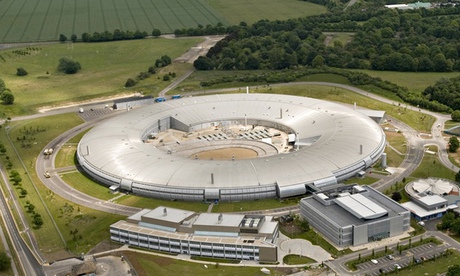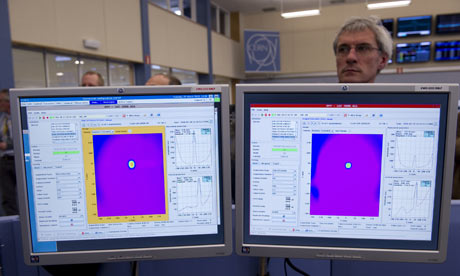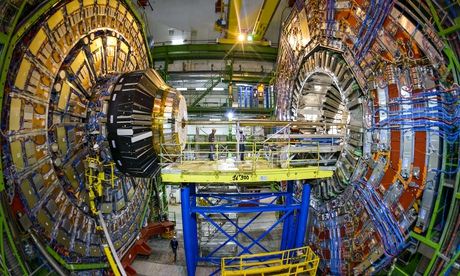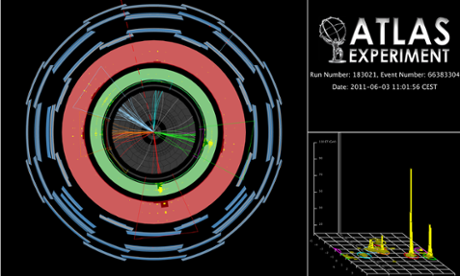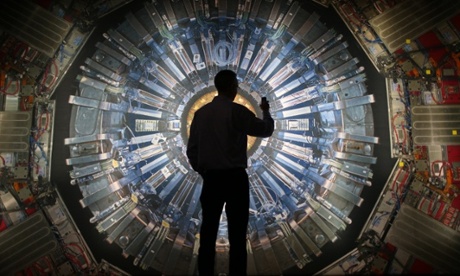The darling of particle physics might be the Large Hadron Collider (LHC) at Cern, but as a practical tool it's no match for the UK's Diamond Light Source. Located at the Rutherford Appleton Laboratory campus at Harwell in Oxfordshire, Diamond is an alchemist's dream, a place where beams of light 10,000 times brighter than the sun are deployed to probe the nature of everyday things.
Diamond is the Marmite of the physics world. Just as the sticky gunk left over from the brewing process was repurposed as a savoury spread, the light that streams from Diamond was originally the waste product of a particle accelerator.
Diamond's 561m-diameter ring, which gives the building its distinctive circular shape, houses a synchrotron. Like the LHC, this is a particle accelerator, in Diamond's case using synchronised pulses from powerful magnets to accelerate electrons to near the speed of light. Synchrotrons were part of the earliest particle accelerator technology, dating back to the 1940s, and were soon found to have an unwanted byproduct. Because they accelerated electrons, they generated light, known as synchrotron radiation.
When an electron accelerates it gives off energy in the form of electromagnetic radiation. Almost everyone owns an electron accelerator – the transmitters in mobile phones generate radio waves by accelerating electrons in aerials. But synchrotrons push electrons to relativistic speeds and the acceleration of electrons around the ring produces a whole spectrum of electromagnetic energy from microwaves, up through infrared, visible light, ultraviolet and x-rays.
This happens even though the electrons travel around the main storage ring at a constant speed, because acceleration is a change in velocity, which combines speed and direction. To keep the electrons in the ring they are regularly shifted through small changes of direction by steering magnets, each of which results in an acceleration and a blast of light.
In the early synchrotron light sources, such as Diamond's predecessor at Daresbury in Cheshire, this acceleration round the ring was the sole source of light, but in a modern, so-called third generation ring, electrons are also given extra acceleration by passing them through a series of alternating magnets to force the particles into a pattern of repetitive oscillations. These devices are known as undulators if they produce a tight, narrow oscillation generating a narrow band of radiation, or wigglers if they produce a wider band.
Around the storage ring are ranged beamlines, exit beams for the radiation, where work stations known unromantically as hutches house the experiments. In Diamond's massive 45,000 sq metre floor space (around eight times St Paul's Cathedral) there are currently more than 20 beamlines, with space for 40 in the final configuration. "When you walk into this big hangar of a place," says Diamond researcher David Cole, "it's like something out of Star Wars."
Though Diamond is a massive project, constructed between 2003 and 2007 with funding split between the Science and Technology Facility Council (86%) and the Wellcome Trust, it was relatively cheap with an initial construction cost around one-tenth of the LHC's £2.6bn. Of course, Diamond is not on the same scale of build, but in terms of what it delivers it more than compensates.
Each year, a remarkably wide range of projects compete for time on Diamond's beamlines, which run 24 hours a day, outside planned shutdowns. The light produced here is beyond anything that a university could deliver in a lab. Diamond's x-ray sources, for example, are 100bn times more powerful than a conventional x-ray tube. While it is possible to produce lasers that develop as intense a blast of light as a synchrotron source, they are nowhere near as flexible because a laser is limited to a narrow range of frequencies, where Diamond produces a wide spectrum. Practically every application of Diamond requires a different frequency, fitting the sample being studied.
The sheer range of applications is remarkable. The powerful blasts of light or x-rays enable scientists to study the makeup of materials in unparalleled detail, deducing the structure of molecules far more complex than the DNA that so challenged researchers in the 1950s, establishing the exact chemical makeups and physical properties of tiny samples and finding subtle variants in the structure of manufactured items that can lead to stressing and failure.
As Professor Trevor Rayment, Diamond's physical sciences director says: "Particle physics machines such as the LHC enable scientists to pursue inspirational goals, such as discovering the nature of dark matter, which most of the universe in made up from, and they deservedly have a high profile… [but] facilities such as Diamond are accelerating discoveries across a vast expanse of science and technology."
He gives the example last year of a team from Oxford, Reading and the Pirbright Institute who "used Diamond's intense x-rays to design a much safer vaccine for foot-and-mouth disease, which is endemic throughout much of the world, costs $5bn [£3bn] a year, and causes much suffering in poor countries".
It would be a shame if particle accelerators working on particle physics were to overshadow Diamond's remarkable work, which not only expands our scientific knowledge but makes possible the development of new drugs, new approaches in electronics and aircraft that fly more safely. The Diamond Light Source is a true national treasure.
The earthworm uncovered
Dr Mark Hodson from York University has been using Diamond in two projects based on a peculiar constituent of earthworm casts. "As a mineralogist, I was interested in rocks and hence soils, but I only gradually realised that biology is also important," he says. "There's plenty of work on bacteria, but I like things I can see and went to an earthworm conference, where an archaeologist was presenting on the importance of balls in worm poo to climate reconstruction."
As well as the usual contents of faeces, earthworm casts contain small granules of calcium carbonate. This is a common mineral – the stuff of limestone, marble and chalk. These roughly spherical granules, around 2mm across, can remain in the soil for tens of thousands of years. They were already of interest for climate research, as they can be dated well from the decay rate of uranium that is incorporated into them, and the balance of oxygen isotopes in the carbonate gives a good measure of the temperature at the time the granule formed, but Hodson has more present-day concerns in his sights.
He initially used a Diamond beamline to determine how effective earthworms might be at cleaning up soil that was contaminated with heavy metals such as lead and zinc, a process known as remediation. These metals can leach out of the soil into ground water, poisoning the water supply. "We were looking for a way to give the metals something to stick to. We had already seen that earthworms can survive in contaminated soils and so began to culture worms in appropriate soils to see if they could lock up the heavy metals in the calcium carbonate, reducing their mobility."
In these earlier experiments, Hodson was using powerful x-rays to provide a spectroscopic analysis of the calcium carbonate granules produced from the contaminated soil to find out how much of the heavy metals were being locked away. The outcome was frustrating – the metals were being held in the calcium carbonate, but not in sufficient quantities to remediate the soil. The worms would not provide an adequate solution in any sensible timescale.
Now Hodson is using an infrared beamline to examine a very different aspect of the granules that could transform our understanding of a key industrial material. Most calcium carbonate comes in one of two crystalline structures, calcite and aragonite, with a small amount of a third, vaterite. But there is a fourth form, amorphous calcium carbonate, that would be very interesting if it could be produced on a large scale, as it lacks the tendency to shear along planes that typifies the crystal structures.
The worm granules contain all four kinds of calcium carbonate, and the amorphous form can last for years. "This is remarkable," says Hodson, "as amorphous calcium carbonate is very unstable. It usually crystallises very quickly. In the lab it might last five minutes. We are trying to find out what causes that stability in the granules."
To perform the experiment, Hodson and his co-workers cut thin slices of the granules and map out the different forms of calcium carbonate every 5 microns (millionths of a metre) through the sample. If it is possible to discover what other substances are stabilising the amorphous form, it could have a whole range of uses, from changing the brightness of paper and other products that use calcium carbonate for whiteness, to reducing the build-up of scale in pipes or modifying the strength of building materials.
The power of Diamond's light source makes it possible to study the detailed constituents in place. "In the laboratory we can identify the presence of various elements with granules that have been ground up. That way we can see what's there, but not why the amorphous calcium carbonate is stabilised. Here [at Diamond] we can match up the locations." The brighter the light, the better the resolution that can be achieved in examining the samples – and Diamond provides an unmatched intensity.
This work is still under way. Hodson estimates they are three to four years from a definitive finding. But the potential of the earthworm to transform our understanding of a substance that has been a key building material since the pyramids is impressive.
Cancers captured
Since 1915, when the father and son team of William and Lawrence Bragg won the Nobel prize for using x-rays to analyse the structure of crystals, it has been apparent that this would be a valuable technique for understanding the way that atoms are linked to form molecules. But it is hard to imagine that the Braggs could have envisaged that their work would provide an essential tool in the search for a mechanism to cure cancers.
Pierre Rizkallah and David Cole from Cardiff University are using the Diamond Light Source's intensely powerful x-rays to establish the modifications needed to give T-cells – a form of white blood cell – the ability to latch on to and destroy cancer cells.
T-cells have a unique ability to look into another cell and determine whether it is friendly or alien. Proteins on the surface of the T-cell called T-cell receptors can scan another cell by locking on to MHC (major histocompatibility complex) molecules, which protrude from the surface of cell. These MHC molecules reflect the internal makeup of the cell – by "reading" them, the T-cell can identify whether the cell it has approached should be ignored or destroyed.
At the moment T-cells rarely attack cancer cells. "The big problem the T-cell has is how to differentiate healthy cells from cancer cells," Cole says. "It is difficult for the T-cells as cancer cells look similar to normal cells. We are looking at whether it's possible to do anything to the interaction so that the T-cells can react."
Initially the team is focusing on skin cancer, but in principle the methods they are using could be applied to any cancer cells.
The first requirement is to determine the complex shape of the receptors on the T-cells, to be able to modify them to lock on to the cancer's MHC molecules. The traditional method, used for example in the determination of the structure of DNA, is to produce a crystal form of the substance to be studied, then blast it with x-rays. As the x-rays interact with the atoms in the repeating structure, they are diffracted, producing a pattern of dots, which is analysed from various directions to allow a painstaking build-up of the structure of the molecule.
This can be a slow process. Rizhallah explains: "It takes hundreds or thousands of exposures to build up the structure. This is where a synchrotron like Diamond is much better than a traditional x-ray source. With a traditional source the image is barely distinguishable. When I first started, using such sources, it took around eight hours to build a single image. [At Diamond] with much higher resolution, it initially took 15 minutes and now is a fraction of a second.
"It wipes out anything we could do in the laboratory. When I started one structure would take three years for a post doc to determine. Now we can analyse three in a day."
Once the receptors are better understood the aim is to discover which parts of the molecular structures are touching each other by using crystals that combine the T-cell receptors and the MHC molecules. From this the aim is to work out how to artificially enhance T-cell receptors to attach more firmly to cancer cells, enabling them to attack and destroy the cancer. Treatment would involve taking a patient's own T-cells, modifying them and returning them to the cancer site.
By providing unique speed and resolution, Diamond Light Source is enabling fundamental research in what could form one of the biggest medical breakthroughs of the 21st century.
Diamond has four public open days a year, when visitors can pay an in-depth visit to the facility.
* This article was ammended on 3 February to correctly indentify the location of the Diamond Light Source as the Rutherford Appleton Laboratory.
